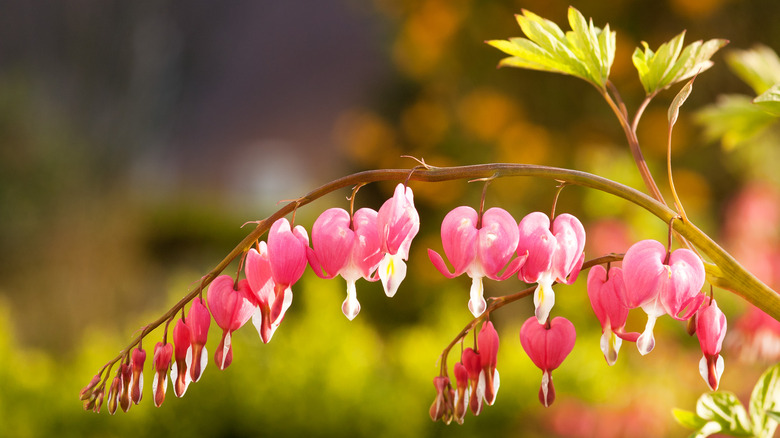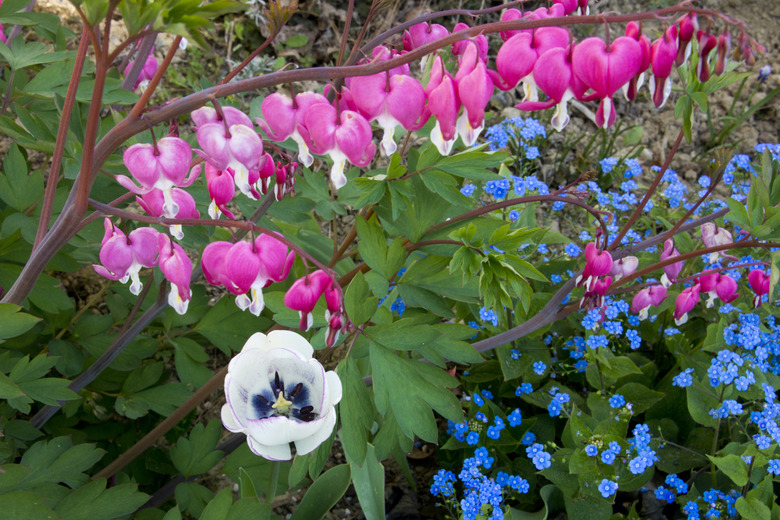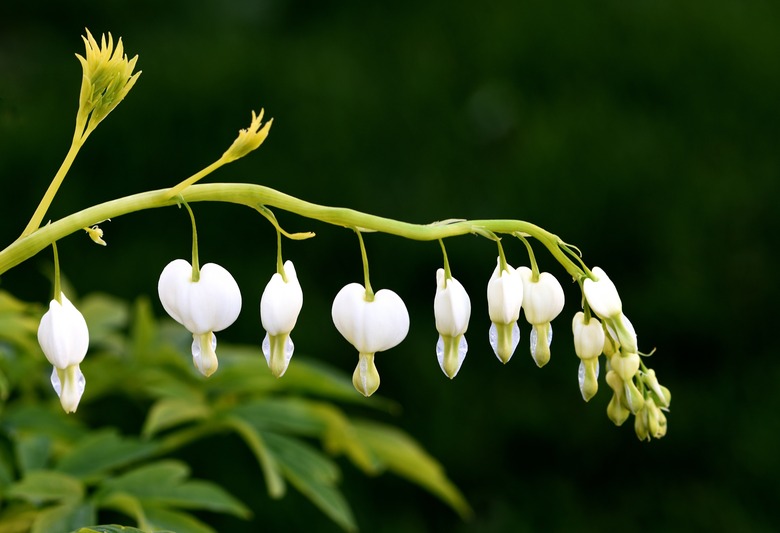How To Grow Bleeding Hearts
We may receive a commission on purchases made from links.
- Best uses for bleeding hearts
- How to grow bleeding hearts
- In what zone do bleeding hearts grow best?
- When should you plant bleeding hearts?
- Soil, sunlight and water recommendations for bleeding hearts
- How to propagate bleeding hearts
- How to winterize bleeding hearts
- Common pests and other problems for bleeding hearts
- Common diseases for bleeding hearts
Although its flowers look quite delicate and truly do look like tiny bleeding hearts, the bleeding heart plant (Lamprocapnos spectabilis, USDA zones 3-9) is a robust species that grows easily in the right conditions. The only problem gardeners tend to have with bleeding hearts is that they are gone too soon. These plants like cool weather and often die back in summer's heat, potentially leaving a sizable hole in your landscape.
Luckily, the bleeding heart is a perennial that will come back again next year. In the meantime, plant lots of showy pink flowers (or subdued white flowers) or add some annuals to the garden to keep things looking lively when the bleeding heart's beauty has passed for the year. You can also plant your bleeding heart in a container and simply bury it in the garden to overwinter when it goes dormant.
Best Uses for Bleeding Hearts
Best Uses for Bleeding Hearts
Bleeding hearts are an excellent choice for shady spots and create an informal, cottage-garden feel. These decorative plants put on quite a show in the late spring and early summer, so plant them where you will see them often. They reach both heights and widths of 2 to 3 feet, although some types are more compact, which allows them to work well as border plants or along shady walkways.
Note that in many areas, bleeding heart plants flower from April through July but may lose their luster in very hot weather so it's crucial to plan your garden accordingly. When these show-stopping pink flowers (or white flowers), are about to go dormant at the end of the growing season, companion plants like hostas and ferns with their lush, green foliage will fill in the gaps that your bleeding hearts leave behind. You can also add some potted plants, annuals or bushy plants that take over the space as they grow.
Rabbits, deer and other common garden pests don't like bleeding hearts and will keep away from them, making them a smart choice in areas where grazing wildlife is an issue. It should be noted, however, that bleeding hearts are toxic. Don't plant them where pets or young children can access them.
How to Grow Bleeding Hearts
How to Grow Bleeding Hearts
- Common Name: Bleeding heart, Dicentra
- Botanical Name: Lamprocapnos spectabilis
- When to Plant: When the danger of frost has passed
- USDA Zones: 3-9
- Sun Exposure: Part shade
- Soil Type: Moist, well-draining soil
- When it's in Trouble: Yellowing leaves, lack of leaves, signs of insect damage
- When it's Thriving: Produces lots of green leaves and has a bushy appearance
Starting Bleeding Hearts From Divisions or Bare Roots
You can start bleeding hearts from seeds, but most gardeners don't do so. It can prove difficult to get the seeds to germinate, and planting divisions or bare roots is much easier.
When planting bleeding hearts, begin by preparing your outdoor planting beds. Bleeding hearts like rich soil, so work some organic matter such as compost into the area before you plant. If your soil drains poorly, work in some peat moss as well to improve the area.
Dig the planting hole deep enough to accommodate all of the plant's roots and make the hole about twice the diameter of the root ball. Position the plant in the hole to the same planting depth as in its original pot and then backfill the hole.
If you're planting from roots, place the bare roots so that the plant's crown is about 2 inches below the soil. Water your new plants or roots gently but deeply. Mulch around them to help retain moisture and keep weeds at bay.
In What Zone Do Bleeding Hearts Grow Best?
In What Zone Do Bleeding Hearts Grow Best?
Gardeners will have success with bleeding hearts throughout USDA hardiness zones 3 through 9. In warmer zones like 8 and 9, bleeding hearts may go dormant around July when the summer heat sets in. Those in cooler zones like zone 3, however, may enjoy a longer flowering season with plants continuing to bloom until late summer or early fall.
When Should You Plant Bleeding Hearts?
When Should You Plant Bleeding Hearts?
Bleeding hearts are best planted in early spring, but wait until any danger of frost has passed. Frost can easily kill young plants. Spring planting gives your bleeding hearts time to establish themselves well before they go dormant for the winter. Because they sometimes do so in the middle of summer, it is best to plant them as early as you can while avoiding late frosts.
Soil, Sunlight and Water Recommendations for Bleeding Hearts
Soil, Sunlight and Water Recommendations for Bleeding Hearts
Bleeding hearts are a bit fussy about their soil and like a pH level between 6.0 and 7.0. Alkaline soil will cause the plant's leaves to turn yellow. It's a good idea to use a test kit to determine your soil's pH level before planting.
Wet feet are also a problem for bleeding hearts. Water the area where you plan to plant until puddles form. If the puddles are still there several hours later, you need to amend your soil or pick another planting spot. Wet, soggy soils are deadly for bleeding hearts, especially during the winter months. Ideally, your bleeding hearts want continually moist soil (but not too wet) that gets about 1 inch of water per week.
Place your bleeding hearts where they will receive part shade. They'll work with a bit of sun but prefer very little. Bleeding hearts enjoy dappled shade but avoid the deep shade of evergreen trees or extremely dense groves.
If you like, you can apply a time-release fertilizer to your bleeding hearts each spring as soon as they flower. Time-release fertilizer releases nutrients into the soil slowly over time rather than giving them a bast of fertilizer all at once. When the bleeding heart flowers die, snip the spent stem off the plant to encourage new growth.
How to Propagate Bleeding Hearts
How to Propagate Bleeding Hearts
To propagate bleeding hearts, wait until the plant is done flowering. Propagation involves cutting a 6-inch length of healthy stem from the plant, removing the bottom leaves of the cutting and planting it in moist sand. In about six weeks, roots will form, and you will have a new plant.
You can also propagate bleeding hearts by dividing them. It's a good idea to divide bleeding hearts every three to four years anyway to keep the plants from getting too large and outgrowing the space you have allocated to them.
To divide bleeding hearts, dig up the plant's root ball and cut it into smaller sections. Make sure each division has plenty of roots and a nice amount of leaves. Robust divisions establish themselves more quickly after replanting than small, scraggly cuttings. You can replant as many of your divisions as you can use or give them to friends and family who are looking to grow this beautiful ornamental in their garden.
How to Winterize Bleeding Hearts
How to Winterize Bleeding Hearts
As perennials, bleeding hearts will go dormant every winter and come back again in the spring. When your plant goes dormant, allow it to die back on its own without interfering. When it has done so, prune off the dead stems, leaving about 1 inch of stem on the plant. This extra inch of plant material will provide a bit of insulation during the winter.
If you choose to grow your bleeding hearts in a container, however, you will have to take steps to protect them from the winter cold. The simplest way is to bury the plants container and all in your garden. Dig a hole that is large enough to accommodate the pot, bury it and cover the area with about 12 inches of straw mulch to provide some extra insulation. Concrete and plastic pots work best for overwintering plants underground. Avoid terracotta, which cracks during freeing and thawing cycles.
Burying the pots allows them to overwinter in the ground as they normally would, continuing to rely on Mother Nature for protection from the elements and to receive enough water to sustain them during their dormancy.
When overwintering container plants, make sure you dig up the containers early in the spring when the ground thaws. If you leave the plants in the ground for too long, they may wake from their winter slumber and start growing while they're still buried. This leads to roots growing out the bottom of the container, anchoring the plant to the ground and making it harder to remove.
Common Pests and Other Problems for Bleeding Hearts
Common Pests and Other Problems for Bleeding Hearts
Slugs and snails both like to munch on the leaves of bleeding heart plants, so keep an eye out for them. If you see a few, picking them off by hand is usually adequate. If you see a large number or are squeamish about plucking them, sprinkle some diatomaceous earth around your plants to keep them at bay. Keep the garden clean as well so that these mollusks don't have leaf piles or other garden debris under which they can hide.
Aphids also can become an issue for bleeding hearts. A blast of water from the hose will remove aphids by dislodging them from plants.
Common Diseases for Bleeding Hearts
Common Diseases for Bleeding Hearts
Although relatively disease-free, bleeding hearts are susceptible to fusarium and verticillium wilts. Fusarium wilt manifests as dark streaks on the plant's leaves and stems, while verticillium wilt literally does cause the plant's leaves to wilt, eventually yellowing and falling from the plant.
Unfortunately, the best way to handle both of these wilts is to quickly remove and destroy plants that show signs of infection. You can prevent wilts by spacing your plants properly to allow for air circulation and making sure irrigation efforts point water toward the plants' roots rather than watering from overhead. Raking up dead leaves and old mulch also helps to reduce the chances of wilt, as does keeping weeds to a minimum.
References
- Gardening Know How: Bleeding Heart Flower Care – How To Grow Bleeding Hearts
- Gardener's Path: Lamprocapnos Spectabilis, Formerly Dicentra Spectabilis
- American Meadows: How to Grow Bleeding Hearts
- Missouri Botanical Garden: Dicentra 'Adrian Bloom'
- Walters Gardens: The Complete Guide to Growing Perennials in Containers
- Horticulture: Companions for Bleeding Hearts


